Daffodils are most associated with European summers but have their origins in southern Europe and Africa, where they naturally spread. These gorgeous bright pops of spring sunshine are incredibly easy to grow, and do well in most parts of Australia provided they are allowed to live by their own cycles.
Follow our guide to growing daffodils in Australia to make sure you get full flushes of vivid blooms every spring.
More...
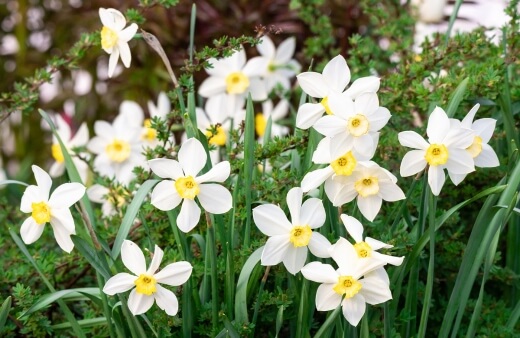
Family: | Amaryllidaceae |
|---|---|
Genus: | Narcissus |
Species: | Various |
Origin: | Southern Europe, North Africa |
Common Names: | Daffodil |
Location: | Outdoor |
Type: | Bulbous perennial |
Growth: | 10-45cm tall, clump-forming |
Sun requirements: | Full sun, to part shade |
Foliage Colour: | Green |
Flower Colour: | White, Cream, Yellow, or Orange |
Flowering: | Late winter, early spring |
Fruit: | None |
Maintenance level: | Low |
Poisonous for pets: | Toxic to cats and dogs, especially the bulb |
What are Daffodils?
Daffodils are bulbous perennials, flowering every year from the same bulb, usually for about ten years, before being replaced by bulbs that have developed from the petals of their original bulb.
They are highly clump-forming plants, but can also spread by seed, and are best left to develop without human intervention after being planted quite densely for instant impact in their first year.
While there are many unique and unusual ways to propagate daffodils, including from their bulb petals, the best ways are the simplest, by digging up and dividing clumps of bulbs, or planting new bulbs directly where you want them to flower.
Natural Habitat of Daffodils
Daffodils are native to Greece, where the genus gained its scientific name, Narcissus from the story of the young man who fell in love with his own reflection (likely thanks to their drooping flowers, peering down at themselves more often than not).
They thrive in moist, warm environments, where they can be allowed to grow and die back naturally, but deadheading helps to force energy back down to the bulb, producing more reliable blooms the following year.
10 Best Daffodil Varieties to Grow in Australia
Any daffodil variety will work in Australia without much effort on the part of the gardener, but the ten below are perhaps the best reflections of the wide range of daffodils that are available from our garden centres.
10 Best Daffodil Varieties to Grow in Australia
Any daffodil variety will work in Australia without much effort on the part of the gardener, but the ten below are perhaps the best reflections of the wide range of daffodils that are available from our garden centres.
1. White Lion Daffodils
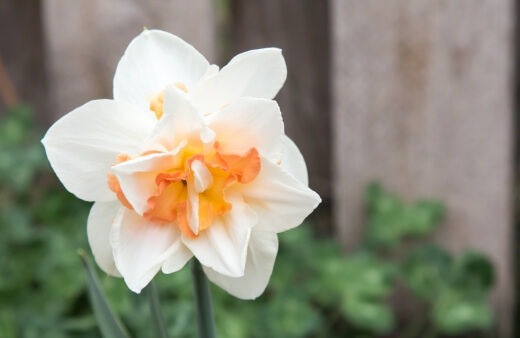
Lion’s Head daffodils are boldly double-flowered, with a cramped cluster of creamy-white petals on 30-40cm tall stalks. They look beautiful in beds and borders, or at the centre of pots and containers, where they provide early colour before other seeded annuals emerge.
2. Tête-à-tête Dwarf Daffodils
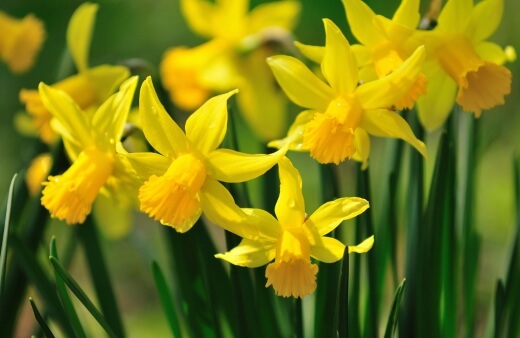
Tête-à-tête is one of the most common dwarf daffodils you can grow, and remains popular thanks to their neat and compact size, paired with delicate translucent petals which catch the spring sun, unlike any other garden plant.
They are incredibly easy to grow and thrive in containers. Despite the advice this article gives for general daffodil growing, they work well in shade, particularly underneath deciduous trees, where spring colour can be hard to come by.
3. Narcissus ‘Paperwhite’

Paperwhites are my favourite daffodil and can be grown indoors through winter to add a pungent vanilla fragrance to your living room. They are highly toxic to cats and dogs though, so keep them out of reach of pets.
These fine, white, multi-flowered daffodils are triggered into growth by changing temperatures as well as day length, so can be grown all year round from dried bulbs, which begin to sprout as soon as they hit soil above 10 degrees.


Get Your Free Guide:
Master Growing Australian Natives eBook
A Must Have Complete Guide for Every Australian Garden
Get Your Free Guide:
Master Growing Australian Natives eBook
A Must Have Complete Guide for Every Australian Garden
Alternatively, they can be grown outdoors just like any other daffodil and will flower reliably in spring, filling the garden with a powerful afternoon scent.
4. Petticoat Daffodils
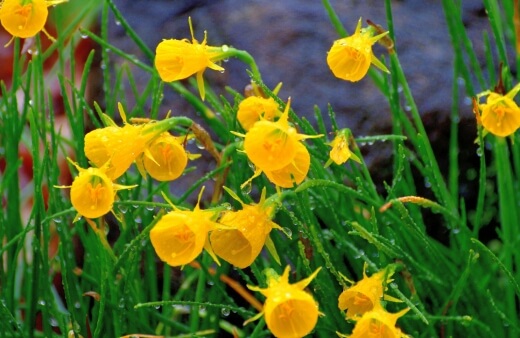
Petticoat daffodils, available in both white and yellow varieties, are a little different from the classic varieties we’re all used to, with dramatically bell-shaped flowers. Their exaggerated cones help to attract pollinators, and mean that they spread well (but slowly) from seed in naturalised patches of lawn, or under wooden canopies.
5. King Alfred Daffodils
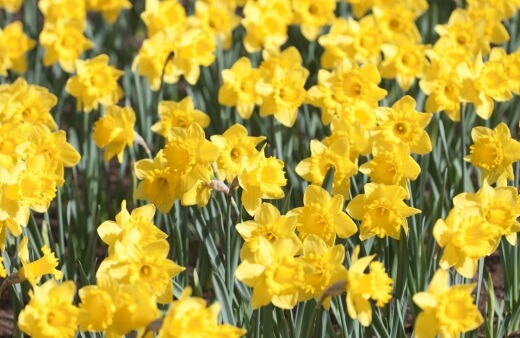
King Alfred Daffodils are a classic trumpet daffodil, with one large custard-yellow flower at the tip of each stem. They are best planted in clusters of bulbs, rather than one bulb by itself, as the weight of the flowers often forces single plants to droop.
6. Salome Daffodils
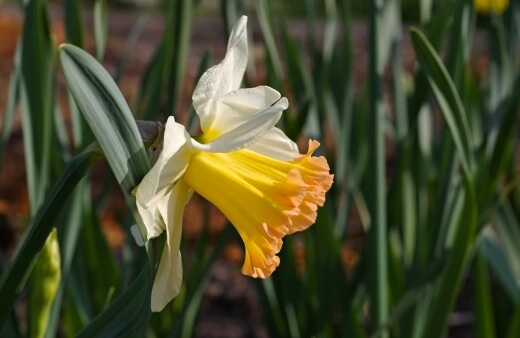
For gardeners looking for softer colours, it’s useful to look at daffodils with paler petals. Salome has creamy white petals, with touches of pink, and trumpets which range from bright yellow to chalky reds.
Their pale bluish stems and leaves help to set off their softer look too, and work beautifully planted densely into pots on patios, either in full sun or part shade.
7. Tahiti Daffodils
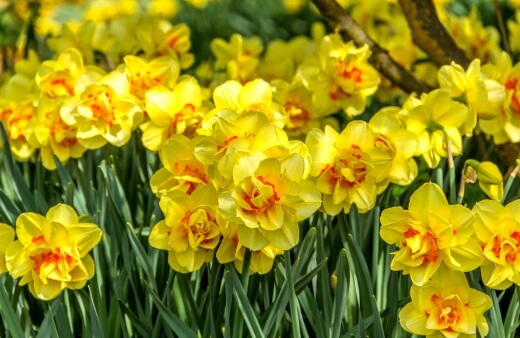
If you like your garden to pop with unusual colour at every stage of the year, try Narcissus ‘Tahiti’ whose tight double flowers burst with bright orange centres, stippling through powder-yellow petals and trumpets.
Tahiti isn’t a great flower for pollinators as access to pollen is restricted, but for ornamental daffodil displays, there are few plants in the Narcissus genus that perform quite as dramatically as Tahiti.
8. Thalia Daffodils
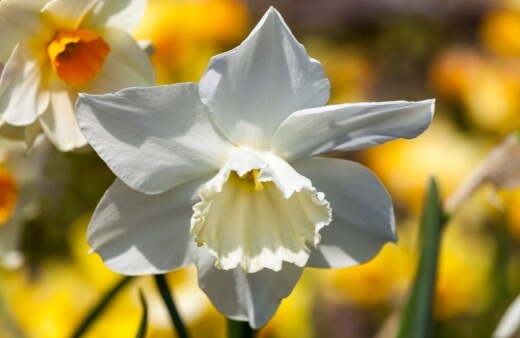
Thalia is an exceptionally tall daffodil, with clean white flowers and wispy petals providing a base for an ornate frilly trumpet. For calming tones in spring and a gentle exit from winter, they really are hard to beat.
Up close, they have a luxurious spring fragrance too, somewhere between vanilla and cut grass, which makes them perfect for cut flowers in vases, typically lasting about one week after cutting.
9. Minnow Daffodils
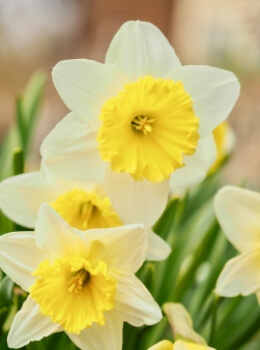
Multi-headed daffodils are interesting to grow, and a great way to get more out of your space. Minnow are a fairly short variety, but they typically produce three flowers per stem, making for a dense display of flowers even in small gardens.
10. Jonquil Daffodils

Narcissus jonquilla is native to Spain and Portugal, and benefits from resilient stems that rarely bend in the wind or under the weight of rain. For reliable flowers that last slightly longer than other types, give them a go.
1. White Lion DaffodilsLion’s Head daffodils are boldly double-flowered, with a cramped cluster of creamy-white petals on 30-40cm tall stalks. They look beautiful in beds and borders, or at the centre of pots and containers, where they provide early colour before other seeded annuals emerge. |  |
2. Tête-à-tête Dwarf DaffodilsTête-à-tête is one of the most common dwarf daffodils you can grow, and remains popular thanks to their neat and compact size, paired with delicate translucent petals which catch the spring sun, unlike any other garden plant. They are incredibly easy to grow and thrive in containers. Despite the advice this article gives for general daffodil growing, they work well in shade, particularly underneath deciduous trees, where spring colour can be hard to come by. |  |
3. Narcissus ‘Paperwhite’Paperwhites are my favourite daffodil and can be grown indoors through winter to add a pungent vanilla fragrance to your living room. They are highly toxic to cats and dogs though, so keep them out of reach of pets. These fine, white, multi-flowered daffodils are triggered into growth by changing temperatures as well as day length, so can be grown all year round from dried bulbs, which begin to sprout as soon as they hit soil above 10 degrees. Alternatively, they can be grown outdoors just like any other daffodil and will flower reliably in spring, filling the garden with a powerful afternoon scent. |  |
4. Petticoat DaffodilsPetticoat daffodils, available in both white and yellow varieties, are a little different from the classic varieties we’re all used to, with dramatically bell-shaped flowers. Their exaggerated cones help to attract pollinators, and mean that they spread well (but slowly) from seed in naturalised patches of lawn, or under wooden canopies. |  |
5. King Alfred DaffodilsKing Alfred Daffodils are a classic trumpet daffodil, with one large custard-yellow flower at the tip of each stem. They are best planted in clusters of bulbs, rather than one bulb by itself, as the weight of the flowers often forces single plants to droop. |  |
6. Salome DaffodilsFor gardeners looking for softer colours, it’s useful to look at daffodils with paler petals. Salome has creamy white petals, with touches of pink, and trumpets which range from bright yellow to chalky reds. Their pale bluish stems and leaves help to set off their softer look too, and work beautifully planted densely into pots on patios, either in full sun or part shade. |  |
7. Tahiti DaffodilsIf you like your garden to pop with unusual colour at every stage of the year, try Narcissus ‘Tahiti’ whose tight double flowers burst with bright orange centres, stippling through powder-yellow petals and trumpets. Tahiti isn’t a great flower for pollinators as access to pollen is restricted, but for ornamental daffodil displays, there are few plants in the Narcissus genus that perform quite as dramatically as Tahiti. |  |
8. Thalia DaffodilsThalia is an exceptionally tall daffodil, with clean white flowers and wispy petals providing a base for an ornate frilly trumpet. For calming tones in spring and a gentle exit from winter, they really are hard to beat. Up close, they have a luxurious spring fragrance too, somewhere between vanilla and cut grass, which makes them perfect for cut flowers in vases, typically lasting about one week after cutting. |  |
9. Minnow DaffodilsMulti-headed daffodils are interesting to grow, and a great way to get more out of your space. Minnow are a fairly short variety, but they typically produce three flowers per stem, making for a dense display of flowers even in small gardens. |  |
10. Jonquil DaffodilsNarcissus jonquilla is native to Spain and Portugal, and benefits from resilient stems that rarely bend in the wind or under the weight of rain. For reliable flowers that last slightly longer than other types, give them a go. |  |
How to Grow Daffodils in Australia
Daffodils can be grown from seed, bulbs, or potted plants but bulbs are the most efficient and budget-friendly way to get started with these reliable spring favourites. Follow our guides below to learn how to plant, grow and care for daffodils in your garden.
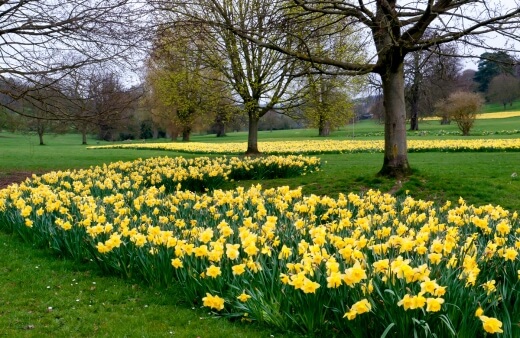
When to Plant Daffodil Bulbs
Plant daffodils in autumn or early winter. Daffodils don’t need a frost to bloom, but they do need to have spent some time in the soil to properly burst into growth which is triggered by changing day lengths and warming soil.
In warmer parts of Australia, you can plant daffodil bulbs in late winter and still get an early spring display, but they will almost always perform better after early winter planting.
Where to Plant Daffodils
Deciding where to plant daffodils is incredibly simple as they thrive in almost all positions. Perhaps the more important consideration is where they actually look best. For me, that has to be in lawns, where they can burst out and add interest to an otherwise flat carpet of green.
But they can also look incredible in densely planted pots. When your daffodils have outgrown their pots and bulbs over-multiply, you can simply tip them out of the container after flowering and plant them, into the garden, in lawns, beds, or borders.
Light & Temperature
You can plant daffodils anywhere and everywhere, but they perform best in slightly dappled shade, with space to spread. Full shade will limit the flowering potential of daffodils in their second year, and full sun can shorten their flowering time.
Soil & Drainage
Daffodils, like all bulbs, do not like sitting in very wet conditions, but unlike tulips and fritillaries, they can cope with some dampness, often growing happily alongside streams, or on the edge of lined ponds.
Well-drained loamy soil is best for daffodils if you can provide it, but even clay soils will support their growth, particularly if they are planted into lawns on clay soil, where the moisture is mitigated by the surrounding planting.
Plant Spacing
Almost all packs of daffodil bulbs will suggest spacing bulbs 5-10 cm apart, but in reality, daffodils are much better planted on mass. Rather than planting a single bulb, plant groups of 5-10 bulbs by digging out sections of soil and dropping them in.
If you can, make sure the bulbs have their pointy side up but don’t worry too much, as they will still grow towards the light even if planted on their side. When daffodils mature, they multiply their bulbs and grow in densely packed clumps.
By planting closer together you are speeding up that process by several years and will have much more striking results that will last for years.
How to Propagate Daffodils
Daffodils can be propagated in a few different ways, and depending on how in-depth you want to go, they can all have their advantages.
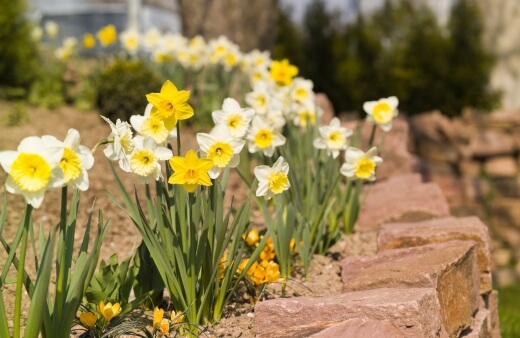
Daffodil Propagation from Seeds
Sowing daffodil seeds is slow (sometimes taking three years before they flower) but allows you to experiment and cross-pollinate different cultivars.
How to Propagate Daffodils from Division
Dividing clumps of daffodil bulbs will provide you with plenty of fresh bulbs to plant, and is easy to do when daffodils have finished flowering. Leave the leaves on the plants, and allow them to die back after digging the bulbs up so each bulb gets sugars passed back from wilting foliage.
You can either plant the bulbs immediately back into the ground or dry them off and store them somewhere cool, dry, and dark until autumn.
Propagating Daffodils from Bulb Petals and Sectioning
Sectioning daffodil bulbs is probably best explained by using onions as an example. Daffodil bulbs develop in layers, similar to the petals of an onion bulb.
Each of those petals attaches to a shared base plate, where roots grow downwards. And each of those petals can be gently removed, keeping a small section of the base plate, to create a new bulb. The process takes a year but will develop a new flowering bulb ready for the following spring if done right.
Another way to encourage the same multiplication is by sectioning the bulb in its entirety; cutting it into four quarters from the top to the bottom, and ensuring each quarter has its own root plate.
With both techniques, leave the sectioned piece of the bulb to dry for a day or two, then plant it into moist compost, mixed with a generous amount of perlite. When roots start to form, you can plant each section into a small pot of compost and plant out in spring.
Caring for Daffodils
Daffodils in beds and borders can be fed with any organic compost in winter by mulching 1-2” thick over the soil surface. Your bulbs will grow through the mulch happily in spring, and the added nitrogen will help power the foliage, which later dies back, feeding the bulbs in return.
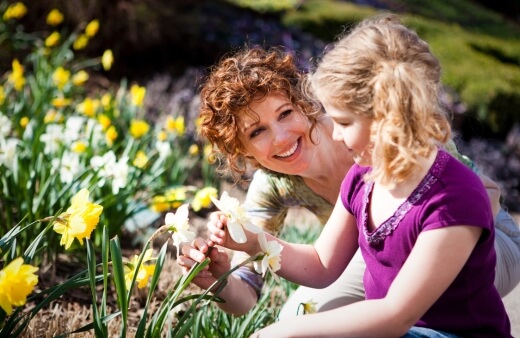
Water Requirements
Daffodils shouldn’t need any watering in the ground, but for those planted in pots, it's worth watering them at the start of spring if they look dry. Once they begin to develop and send up foliage, they should only be watered if their containers are so dry that the leaves are wilting.
Repotting Daffodils
Daffodils in pots can usually stay put for about three years before bulb multiplication risks splitting the pot. When daffodils are shooting up very densely, wait until they stop flowering, then tip the pot out completely and replant half the bulbs back in.
Move the remaining bulbs into the garden, or into a new pot ready for next year.
Deadheading
Daffodils can self-seed, but it’s a slow process. The most reliable way to maintain healthy flowing daffodils is to deadhead as soon as they finish flowering. This will redirect energy back into the bulb, producing better flowers next year, and encouraging bulb multiplication.
How to Take Daffodil Cut Flowers
Daffodils make wonderful cut flowers in spring. Their flowers last in vases for up to a week, and their fragrance is easier to appreciate indoors and away from spring grass cuttings, and the tail end of winter flowering shrubs.
To harvest daffodil flowers, cut each stem right back to the ground with clean scissors. The hollow stem will dry quickly, so place it immediately into a bucket of water with two tablespoons of vinegar.
The vinegar helps to sterilise the cut point, and slows down degradation, allowing moisture to reach the flower so the stem remains rigid for longer.
Common Narcissus Pests and Diseases
Other than bulb rot (caused by waterlogging) Narcissus yellow stripe virus and Narcissus mosaic virus, there aren’t many pests or diseases that affect daffodils in Australia. Ensuring they are kept away from waterlogged soil, and the foliage isn’t watered unnecessarily will generally prevent any problems.
If mosaic virus is spotted (freckled dark lines running across leaves) or yellow stripes running all the way up a leaf, they will reduce flowering and vigour.
If you do spot these viruses, it’s important to remove the affected bulbs and those in the nearby area. These viruses are transmitted by microscopic nematodes so very hard to stop altogether, but removing affected plants will reduce the spread by aphids and winged insects.
Here is our in-depth guide on how to get rid of aphids and prevent them from coming back.
Daffodils Frequently Asked Questions

What is the best month to plant daffodils in Australia?
The best month to plant daffodils in Australia is March, but in warmer parts of the country, you can plant bulbs later in April or May.
Do daffodils grow back every year?
Daffodils grow back every year, but you can boost their flowering vigour by deadheading each year after flowering, producing better displays every year onwards.
What to do with daffodil bulbs after flowering?
After flowering, daffodil bulbs in pots can either be stored in dry, dark, cool conditions until they are ready to plant again, or planted into the garden. However, there is no reason to remove daffodil bulbs from the ground as they will happily remain dormant until next spring.
What is the correct way to plant daffodil bulbs?
Daffodil bulbs should be planted with the root plate facing the ground and the pointed end facing up. The pointed side of a daffodil bulb is where the main stem and leaves burst out, so planting this facing the sky makes it much easier for them to reach the surface.
Do daffodils spread?
Daffodils spread slowly in most gardens but can spread both by seed and from bulbs. As they are fairly slow spreading, they are easy to manage, and make useful plants for gardeners on a budget, as they can be divided to encourage spreading each year.
How many years do daffodils last?
Daffodils typically flower for about five years from each bulb but can continue flowering for ten years. In reality, the majority will fade quicker than that, but be replaced by their bulblets and bulb divisions within a few years to maintain stronger flowering.
How many daffodil bulbs should I plant together?
Daffodils should be planted in generous groups or at least 5 bulbs, but 10-15 will make for a more natural-looking clump, particularly for taller varieties like lion’s head.
Can you plant daffodils too deep?
Daffodil bulbs should be planted at a depth three times the height of their bulb. So for a 5cm bulb, make the base of the planting hole 15cm deep. For gardens where squirrels and digging mammals are a problem, plant them slightly deeper, but no more than four times their height.
Wrapping Up Our Daffodils Growing Guide
Daffodils are the perfect start to any gardening year; the ideal plant that can be left in the ground and forgotten about until it bursts through the soil with joyful yellow beams of translucent petals.
They are as good-looking as they are easy to grow, so you’ve got no excuse. Get out there and plant your daffodil bulbs before it’s too late to make the most of next spring now!
Published on April 6, 2023 by Maisie Blevins
Last Updated on February 23, 2025




